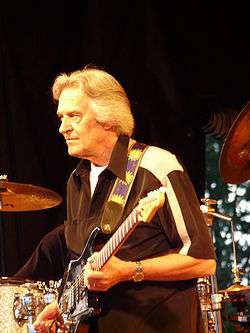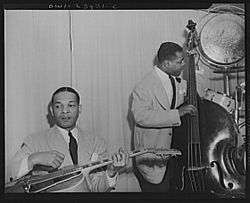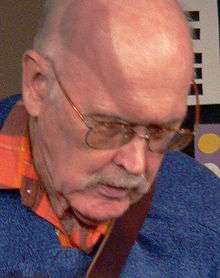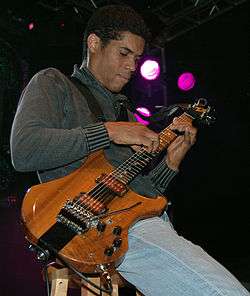Jazz guitarist
Jazz guitarists are guitar players (guitarists) who play jazz music on the guitar using an approach to playing chords, melodies, and improvised solo lines which is called jazz guitar playing. The guitar has fulfilled the roles of accompanist ("rhythm guitar") and soloist in small and large ensembles and also as an unaccompanied solo instrument.
In the 1930s, before guitar amplifiers were widely used, it was difficult for jazz guitarists playing acoustic instruments to be heard over drums, piano or horn sections. As a result, jazz guitarists tended to act as accompanists, strumming chords as part of the rhythm section. Once the first guitar amplifiers were developed in the 1930s, electric guitarists such as George Barnes and Charlie Christian were able to project their solo sound over a jazz ensemble.

The history of jazz guitar has been an integral part of the wide-ranging history of jazz. The early guitar players were the great blues singers who accompanied themselves on the guitar. By the 1930s, guitarists gained prominence in jazz and some were even featured performers, such as Carl Kress (1907–1965), who recorded in 1927 with Bix Beiderbecke. In Europe, Django Reinhardt (1910–1953), a Belgian gypsy jazz guitarist recorded with his Quintette du Hot Club de France. Beginning in 1939, Charlie Christian played with Big Band Swing bandleader Benny Goodman, and in the bebop era, Tal Farlow was notable for his virtuoso playing.
In the 1960s, guitarists tended to play in small groups, such as Jim Hall, who did his best work in duos with Bill Evans, Ron Carter and others. Wes Montgomery was a self-taught guitarist who used his right thumb rather than a plectrum (pick) to produce his unique sound in his late-1950s and 1960s hard bop recordings. Joe Pass pioneered solo guitar with chordal substitutions in his duos with Ella Fitzgerald. Grant Green was known for his 1960s organ trio music. Fusion guitarists such as Larry Coryell (1943- ), John McLaughlin, Pat Metheny, and Allan Holdsworth combined the sound and energy of rock with jazz-style improvisation.
1900s to 1920s
The history of the guitar in jazz is rooted in the great blues singers who accompanied themselves on the acoustic guitar, such as Blind Lemon Jefferson, Blind Arthur Blake, Big Bill Broonzy and Huddie "Lead Belly" Ledbetter. The banjo, because of its loud volume, was an early stringed accompaniment instrument in jazz in New Orleans and Dixieland music. Banjoists such as Johnny St. Cyr (1890–1966) and Bud Scott (1890–1949) also played guitar in jazz bands of the 1910s-1920s.[1] Early jazz guitarists included Eddie Lang (1902–1933),[2] Nick Lucas (1897–1982),[3] Lonnie Johnson (1889–1970) and Snoozer Quinn (1907–1949).[1]
1930s

Even as late as the early 1930s sophisticated jazz orchestras such as the Duke Ellington band still used a banjo to provide a rhythmic pulse. During the 1930s, though, guitarists gained prominence in jazz and some were even featured performers. Carl Kress (1907–1965)[4] and Dick McDonough (1904–1938)[5] made an early guitar duo recording in 1934. Kress was featured with the Paul Whiteman Orchestra in 1926 and recorded in 1927 with Bix Beiderbecke. He initially played banjo and four-string guitar, changing over to six-string guitar in the 1930s. Kress used an unorthodox tuning that he created for himself. He played in the 1950s on the Garry Moore television show and into the 1960s in a duo with George Barnes. McDonough led radio and performing bands and performed with many other musicians such as the Dorsey Brothers.
Other successful jazz guitarists of the period included George Van Eps (1913–1998) and Freddie Green (1911–1987), who played rhythm guitar in the Count Basie Orchestra for 50 years.[1] George Van Eps (1913–1998) began recording as early as 1934 and taped his last records in 1996.[6]
In Europe, Django Reinhardt (1910–1953), a Belgian gypsy jazz guitarist recorded with his Quintette du Hot Club de France with violinist Stéphane Grappelli (1908–1997), a French jazz violinist. Reinhardt was an influential figure in jazz and among jazz guitarists as a soloist, accompanist and composer.[7][8] The Quintette du Hot Club de France included Django Reinhardt's brother Joseph Reinhardt as well as several other Gypsy guitarists and non-Gypsy musicians. Because of international commerce, records featuring Django Reinhardt were heard in the United States and inspired many future famous jazz guitarists. Django's early style was influenced by the jazz of the time, including Louis Armstrong and was later influenced by bebop musicians such as Charlie Parker and Dizzy Gillespie. In 1946, Duke Ellington brought Django to the United States for a series of concerts.
Jazz guitar reached a watershed with the development of amplification using a magnetic pickup and amplifier. With its amplifier, an electric guitar could be as loud as horns, drums, and piano put together. This dramatically changed the way that the instrument could be used, because before amplification was available, the guitarist would just play chords, because single-note melodies would be inaudible. One of the very first jazz guitarists to experiment with the electric guitar was Eddie Durham (1906–1987) who was playing one as early as 1938.[1] Durham showed the instrument to Charlie Christian (1916–1942) in 1937 and to Floyd Smith. On March 16, 1939 Smith recorded "Floyd's Guitar Blues," perhaps the first hit record featuring electric guitar. But it was Christian who was to become the central figure of the electric guitar revolution in jazz, playing with Benny Goodman after an audition on August 16, 1939. Christian was influenced by the records of Django Reinhardt, learning some of his solos note-for-note.
1940s
The 1940s saw jazz guitarists become firmly established as soloists in their own right as well as accompanists. Playing with Nat King Cole brought Oscar Moore (1916–1981) to prominence in jazz and popular music. Moore was a pioneer for the role of jazz guitar in the small jazz ensemble and played with Cole for nearly a decade.[9] Moore also played with Lionel Hampton and Art Tatum. Bill DeArango (1921–2005) played guitar with musicians of the caliber of Coleman Hawkins and Dizzy Gillespie.[10] Billy Bauer (1915–2005) was a member of Woody Herman's first Herd and also played with Benny Goodman and Jack Teagarden. Bauer was at the forefront of bringing the guitar into bebop, playing with Lennie Tristano and later Lee Konitz.[11]
Bill DeArango (September 20, 1921, Cleveland, Ohio - December 26, 2005, Cleveland) was an American jazz guitarist. Jason Ankeny of Allmusic called him "Arguably the most innovative and technically accomplished guitarist to emerge during the bebop era".[1] DeArango was an autodidact, and played in Dixieland jazz bands while attending Ohio State University. He served in the Army from 1942-44, then moved to New York City, where he played with Don Byas, Ben Webster, Charlie Parker, Dizzy Gillespie, Sarah Vaughan, Slam Stewart, Ike Quebec, Ray Nance, and Eddie "Lockjaw" Davis.
1950s and 1960s

In the 1950s, innovators such as Johnny Smith, and other players carrying over from the 1940s like Joe Puma, Bucky Pizzarelli, Tony Mottola, Jim Raney, Oscar Moore (of Nat King Cole's trio), Barney Kessel and others including Joe Pass, Herb Ellis, and Tal Farlow, created the fertile ground for players such as Wes Montgomery and his progeny who helped to evolve jazz guitar into its most modern form. Ellis, a protégé of Pass and Kessel, accomplished technique and elegant lines that reached a wide public through the recordings of Oscar Peterson's trio. During the same period, Farlow's bebop virtuoso playing did much to make up the ground between the guitar and the other "frontline" instruments such as saxophone and trumpet. Farlow was a direct influence on many guitarists such as John McLaughlin.
Johnny Smith, whose "Moonlight in Vermont" and "Walk Don't Run", among the many, especially set the new gold standard for technique, expanded chord voicings and outside diatonic playing, setting a new bar to be met and eventually surpassed by Wes Montgomery, who was to jazz what Eric Clapton and Jimi Hendrix were to electric blues. Montgomery was a direct influence not only on guitarists but all musicians, with players such as Pat Martino and George Benson being the most noteworthy guitarists to carry on Montgomery's legacy of dissonant riffs, arpeggios, passing chords and of course, his hall mark, octave solos.
Jim Hall, who grew up in Cleveland, Ohio, was a masterful melodic player, composer, and arranger, who did some of his most important work in duos with Bill Evans, Ron Carter and others. Hall had a melody-based, motivic approach to improvisation and is renowned for his more "intellectual" approach to single-line solos with emphasis on selection, rhythm and intricate harmonies rather than speed. Joe Pass stands above all the aforementioned players with his ability to improvise an entire composition without accompaniment, and literally set the template for over all contemporary jazz guitar, combining the technical prowess of Johnny Smith and Django with the dissonant expressions of Montgomery. He pioneered solo guitar with chordal substitutions in his duos with Ella Fitzgerald or Oscar Peterson sessions and along with Montgomery, is now one of the most copied jazz guitarists within the genre. Pass can be considered a critical link between old school jazz guitar and the post-Montgomery dissonant precursor to fusion within the jazz guitar genre. Pass's instructional videos and books are among the most popular in the world of jazz guitar.
Kenny Burrell (born 1931), often understated and lyrical, did recordings in the 1950s with Dizzy Gillespie and John Coltrane and led his own groups. Lenny Breau (1941–1984) performed using an ensemble improvisational playing, along with a more orchestral finger-style solo jazz guitar. He used many diverse elements of music, including closed voicings, flamenco-style guitar, use of varied rhythms, fingered harmonics, modal jazz harmony, an intimate knowledge of inversions and tritone substitutions, and a great understanding of bebop. Burrell was a contemporary of Wes, Joe Pass, Ellis and Hall but was not as fluid as they were in terms of pure solo guitar. Charlie Byrd (1925–1999) did nylon-string guitar recordings with saxophone player Stan Getz which helped popularize Brazilian bossa nova and samba music in North America.
George Benson's (born 1943) success as a pop vocalist in the 1970s made him a household name, but he was an influential jazz guitarist in the 1960s, particularly with his organ trio recordings with organist Jack McDuff. Benson's early work on Columbia and CTI records demonstrates the strong influence of Wes with the articulation of Johnny Smith and Tal Farlow. Grant Green's funky 1970s organ trio music makes him a favorite with 2000s-era lounge and club DJs, but much of Green's best jazz work can be found in his 1960s output. Grant Green's style was full of groove and tone, and it is hard to replicate. Fusion guitarist Larry Coryell (born 1943) was among the first to combine the sound and energy of rock with jazz lines in the late 1960s.
1970s and 1980s
John McLaughlin pioneered jazz-rock fusion in the 1970s. John Abercrombie has recorded with Billy Cobham, Jack DeJohnette and the Brecker Brothers. He also often explores the parameters of jazz fusion and post bop. Pat Metheny is a Missouri-based guitarist and leader of his own band, the Pat Metheny Group with Lyle Mays on piano. Allan Holdsworth is a fusion virtuoso noted for his fluid, chromatic, lines and for his distinctive legato guitar technique. Holdsworth's influence can be felt outside of jazz, in heavy rock players such as Tommy Bolin, Edward Van Halen, Fredrik Thordendal, and Joe Satriani. Ted Greene, a solo guitar performer and music educator influenced LA guitarists including Steve Vai and Steve Lukather with his chord melody work. In 1976 former Return to Forever member Al Di Meola shook up the guitar world with Land of the Midnight Sun becoming one of the most influential guitarist of the decade.
Mike Stern, who came to prominence with Miles Davis during the 1980s, has a unique take on fusing blues rock guitar with be-bop lines in extended improvisations. Bill Frisell introduced folk and bluegrass music into jazz, use of intervals rather than single lines, combining harmonics and fretted notes. John Scofield played and collaborated with performers such as Miles Davis, and Billy Cobham, and groups such as Medeski Martin & Wood. At ease in the bebop idiom, Scofield is also well versed in jazz fusion, funk, blues, and soul.
1990s and 2000s

Stanley Jordan is an American jazz/jazz fusion guitarist, best known for his development of the touch technique for playing guitar.
John Pizzarelli is a jazz guitarist, singer, songwriter who scat sings in unison with his guitar line.
Kurt Rosenwinkel is known for his distinct sound and style of improvisation that is influenced by diverse artists.
Royce Campbell, who toured with composer Henry Mancini for 19 years, is featured on dozens of recordings, both as a leader and as a sideman. Drawing on a range of influences from Wes Montgomery to Joe Pass, Campbell has been noted for his tone and melodic feel.
References
- 1 2 3 4 Summerfield, Maurice. 1998. The Jazz Guitar: Its Evolution, Players and Personalities Since 1900. United Kingdom: Ashley Mark Publishing.
- ↑ Eddie Lang
- ↑ Nick Lucas, The Crooning Troubadour and his Guitar
- ↑ Classic Jazz Guitar - Guitarists
- ↑ Classic Jazz Guitar - Guitarists
- ↑ Classic Jazz Guitar - Guitarists
- ↑ Delauney, Charles. 1981. Django Reinhardt. United Kingdom: Ashley Mark Publishing.
- ↑ Dregni, Michael. 2004. Django: The Life and Music of a Gypsy Legend. New York: Oxford University Press.
- ↑ Classic Jazz Guitar - Guitarists
- ↑ Classic Jazz Guitar - Guitarists
- ↑ Classic Jazz Guitar - Guitarists
.